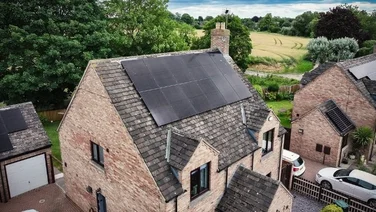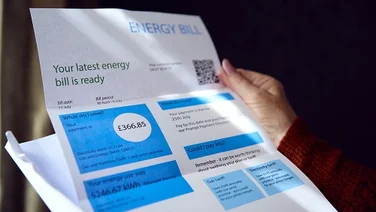- What’s on this page?
- How much does electricity and gas cost in Scotland?
- Should Scotland be paying less than England for electricity?
- Why is Scotland paying more for electricity?
- What should electricity cost in Scotland?
- Can we expect the current UK energy system to change?
- Should Scotland also be paying less for gas?
- Summary
✔ In February 2022, Scots paid 40–50% more on energy bills than Londoners
✔ Most of Scotland’s renewable electricity comes from cheap wind energy
✔ Scotland’s on-shore wind energy costs just 3.7p per kWh
Energy bills have risen dramatically over the past year – and are predicted to continue this trend for at least another two years.
But weren’t we told that the more renewables we have in the country’s energy mix, the less expensive our bills would be? In theory, that’s correct. But there are a few key factors holding us back from cheap renewable energy – namely the country’s outdated energy market.
Although the whole of the UK is enduring extortionate energy prices, Scotland is bearing the brunt of this situation. Despite generating electricity from almost 100% renewable sources, the nation is still paying the same amount for its energy bills as the rest of the UK – and sometimes even higher.
Here’s why this shouldn’t be the case.

What’s on this page?
How much does electricity and gas cost in Scotland?
Energy prices in Scotland are currently pretty similar to the rest of the UK. According to Ofgem’s latest figures (based on the October 2022 price cap rise), the average annual dual tariff energy bill for a medium-sized home in Southern Scotland is £2,504, compared to £2,494 for Northern Scotland.
These figures don’t shy too far away from the national average of £2,495.
However, Scotland’s energy bill figures fluctuate dramatically each year. For example, in February 2022, the Office for National Statistics (ONS) estimated that the average property in Scotland paid 40–50% more on energy bills than households in London.
Further research found that Scotland had the highest average energy bills in 2021, paying roughly £1,651 per year, compared to £1,554 per year for people in England and £1,525 for people in Wales. The study found that people in Shetland and Orkney were paying the most.
Like the rest of the UK, Scottish businesses are also suffering from these extortionate energy prices, as they don’t benefit from the price cap. It was reported in September 2022 that many small businesses in Scotland could see increases of up to 500% on their 2023 energy bills.
Should Scotland be paying less than England for electricity?
Yes, technically households in Scotland should be paying less for their electricity. After all, almost 100% of the electricity Scotland generates (including exports) comes from renewable energy sources, which are far cheaper than fossil fuels. Surely it’s only fair that the nation sees the benefits of this?
In fact, most of Scotland’s renewable electricity comes from wind energy, which is nine times cheaper than gas.
In terms of the electricity that Scotland actually consumes, 62% of it comes from renewables, with an additional 26% coming from nuclear power. That means 88% of Scotland’s energy consumption comes from low-carbon sources, rather than gas and oil.
Data from government Energy Trends report, December 2021
Despite consuming electricity that is 62% renewable – primarily wind power, the second cheapest source of energy in the world – Scotland is still dealing with energy bills either in line with the UK average or even higher.
This is problematic for two reasons:
- Electricity is a valuable resource in Scotland, since a lot of the rural areas in the country don’t have access to gas, so they’re more dependent on electricity and oil
- Many areas of Scotland – especially the northern regions – experience the coldest temperatures in the whole of the UK, which means properties need to be heated for longer periods of time
Graeme Dey, member of the Scottish National Party, blamed this situation on the UK government’s lack of action, claiming, “Under Westminster control, the vast revenue from Scotland’s oil and gas industry has been squandered by UK governments for decades, and now it is consumers in Scotland who are getting hammered with higher average energy bills than anywhere else in the UK.”
Why is Scotland paying more for electricity?
Scotland’s expensive energy bills mainly come down to the UK’s outdated energy market – a system that is still determined by fossil fuels and not cheap renewables.
Professor Michael Grubb, from UCL Bartlett School of Environment, Energy & Resources, claims that “the design of electricity systems has failed to catch up with the revolution in renewable energy”.
Grubb explains that the UK electricity market is seeing huge price rises because it relies on the most expensive generator setting the price, which is usually fossil fuels. This is because some gas plants need to run almost constantly, which they won’t do unless the electricity price is high enough to cover their operating cost.
And since Scotland is part of the UK, it also has to deal with this system. So despite 62% of its energy mix coming from renewables, Scotland is experiencing some of the most expensive energy bills in the world because its energy market is determined by gas.
Ofgem also states that energy rates are just averages, and will vary depending on the region the customer lives in, the payment method carried out, and the type of meter the customer has at home.
Ways in which your region can affect your energy bill prices:
- The number of customers the energy company has in the area – Energy companies can bulk buy from generators for densely populated areas. But if there are relatively few people in the area, which applies to most of Scotland, then the per-unit cost is driven up
- The different charges imposed on the energy supplier – Energy suppliers pay local distribution networks a fee for using their services, which will vary depending on the location
- Energy usage by customers in your area – Local distribution networks factor weather conditions into their costs. This means, in regions where it gets colder, such as Scotland, customers tend to use more electricity to heat their homes than the rest of the UK
Would Scottish independence lead to cheaper energy bills?
Scottish independence is a controversial debate – but the recent energy crisis is the latest example of why Scotland could benefit from distancing itself from the rest of the UK.
Scotland’s renewable growth is being held back by the UK’s outdated National Grid, which has lacked proper investment for decades.
But if Scotland were to become independent, it could operate as a singular zone, setting the price for electricity across Scotland while still exporting renewable energy to the rest of the UK for a higher price.
By altering the system this way, Scotland’s energy market would be determined by renewable energy, rather than fossil fuels. Not only would this lead to cheaper energy bills, but it would also encourage more renewable development in Scotland.
If independence went ahead, Scottish leaders would also likely create a sovereign wealth fund, since the country sits on the North Sea Oil developments. Shetland started a small fund in 1976, when the Sullom Voe Oil Terminal began operating, which is now worth £460 million, and supports the council-run initiative to develop hydrogen and wind power.
Some experts have suggested that the Scottish sovereign wealth fund could be similar to Norway’s success. Norway’s £1.3 trillion wealth fund is the biggest in the world, and the Norwegian Government is using it to pay 80% of households’ energy bills during the energy crisis.
The fund also provides billions to support former oil workers, build Norway’s green energy infrastructure, and invest in renewable technology.
What should electricity cost in Scotland?
Since 62% of the electricity consumed in Scotland already comes from renewables, the country’s energy prices should be far lower than they are right now.
Scotland also provides the rest of the UK with wind power, which is the second-cheapest fuel on the planet. In July 2022, it was announced that offshore wind farm operators will sell power for as little as £37.35 per megawatt hour – or 3.7p per kWh.
To compare, Scottish customers are currently paying 34p per kWh for electricity, and 10.3p per kWh for gas.
Earlier this year, environmental campaigner Alastair McIntosh commented: “The latest Scottish offshore wind energy price: 3.7 pence/kWh unit. Melt that into the political equation when your bill charges 28p (pence/kWh unit) or whatever it’s going to be when the cold sets in again. And remember, energy policy is devolved to Westminster. This is outwith Scotland’s control.”
The Scottish government is also aiming to further increase renewable capacity, setting the goal to generate 50% of Scotland’s overall energy consumption – not just electricity – from renewable sources by 2030. But this will only benefit the Scottish public effectively if the energy market is modernised.

Can we expect the current UK energy system to change?
Yes, the government announced in July 2022 that it will be updating and improving the UK energy market. The project, named The Review of Electricity Market Arrangements (REMA), aims to decarbonise the electricity sector by 2035.
It’s still very early days for REMA, which means there are no concrete plans in the pipeline – and no earmarked budget either.
However, the government has stated that the project will explore ways of updating the system to reflect the rise in cheaper renewable electricity – something that will have a direct impact on energy costs in the UK.
The government’s announcement also suggests that it will be introducing incentives for consumers to draw energy from the grid at cheaper rates when demand is low, or when it’s particularly sunny and windy.
Should Scotland also be paying less for gas?
Like the rest of the UK, Scotland’s energy prices are going up as a direct impact of Russia’s war in Ukraine.
However, with enough gas production to cover its own needs whilst still having a surplus to export to other countries, Scotland’s gas prices should be cheaper. Scotland is even thought to be the largest producer of oil and the second-largest producer of gas in Europe.
Scotland doesn’t actually rely on Russian gas very much – as only about 2% of the UK’s total gas consumption comes from Russia. Energy Secretary Michael Matheson commented: “Scotland and the UK as a whole has security of energy supplies as it stands at the present moment. It has a very low reliance on importing gas from Russia, apparently around 2%, which could easily be displaced by alternative routes.”
On top of this, Scotland doesn’t actually rely on gas very much. Out of the nation’s total electricity consumption, only 10% comes from gas. This is most likely driven by the fact that many rural parts of Scotland – which make up a large portion of the country – don’t have access to gas, and have to rely on our sources of energy.
Summary
Renewable energy is the way forward – not only will it help the environment but it’ll also lead to cheaper energy bills for households around the world.
And with an energy mix that consists mostly of low-carbon energy sources, Scotland should be experiencing some of the cheapest energy bills in the whole of the UK. But this will only be the case if the government modernises the UK energy system, to make sure it isn’t determined by fossil fuels.






